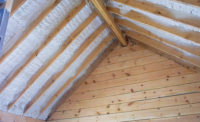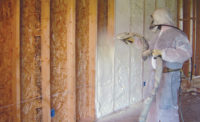In the heart of the Shenandoah Valley in Elkton, Virginia, brew giant MillerCoors operates a large facility. Originally established in 1987, the plant employs almost 500 workers who produce up to eight million barrels of beer annually for the parent company’s biggest brands and brews including Coors Light, Miller Lite, Blue Moon Belgian White Ale, Miller High Life and Keystone Light. A $300 million build-out in 2007 has made this plant one of the most modern large-scale breweries in North America.
One of the smallest, yet most important, parts of the plant is the yeast propagation lab. Yeast propagation is an undeniably important process in beer production as it directly influences the taste of the beer. Yet propagation requires exacting variables. For example, constant water and room temperatures are necessary for yeast to be propagated correctly.
MillerCoors had been having trouble keeping the temperatures in the lab constant, specifically in hot summer months. Various experts, including HVAC techs (who installed a new system), were brought in to try and get the room to remain at stable temperatures. At one point, a recommendation was made to install fiberglass insulation above the drop ceiling. However, that also did not solve the issue and scientists continued to struggle to maintain their 55- to 59-degree Fahrenheit temperature threshold.
Eventually Elite Insulation & PolyPro, LLC, a Virginia-based insulation contractor, was called in to assess whether the facility’s insulation was the root cause. “When we arrived, scientists explained to us that identical yeast propagation is essential because it ensures each glass or bottle of beer tastes exactly the same as the last one,” says Ken Wells, SPFA PCP master installer and owner of Elite Insulation & PolyPro.
Upon review of existing wall structures and insulation in the lab, Elite’s team discovered the exterior walls were cinder block with hollow cores. Above the drop ceiling was a patchwork of R-30 batts of insulation. Above that was 10 feet of block wall extending all the way to the facility’s concrete ceiling. Many of the blocks above the drop ceiling had unsealed holes allowing pipes and ducting to pass through the attic-type space. These holes enabled stack effect, or the ventilation and infiltration of air due to the density differences between air in and outside of the lab. As a result, air flow pushed through the block cores, the fiberglass insulation in the ceiling and, finally, out of the holes in the block wall near the concrete ceiling.
“We ultimately presented a plan of core filling the block walls up past the drop ceiling threshold and applying closed-cell spray polyurethane foam on the walls and ceiling above the drop ceiling, over-lapping the core filled block,” says Wells. “Sealing various penetration holes in the block, creating a proper insulation envelope and core filling to stop the continuous stack effect was the goal. The fiberglass batts above the drop ceiling were also removed when the spray foam application was complete.”
Elite Insulation selected Lapolla FOAM-LOK 2000-4G, a closed cell, energy efficient spray foam, for the lab retrofit. The insulation is the first in its class to leverage HFO technology in its blowing agent. The innovation offers exceptional environmental benefits including the elimination of ozone depletion potential (ODP) and the dramatic reduction of global warming potential (GWP of less than 1), as compared to older spray foam systems. While temperature control was the primary goal of the lab project, FOAM-LOK 2000-4G also provides impressive energy efficiency performance by reducing energy demands in the structure.
Since the interior and exterior of the lab was finished, painted block with cabinets attached, there was no other area of the lab walls to insulate than the block areas. Half inch holes were drilled, where allowable, and block cores were filled with Lapolla FOAM-LOK 500 open cell spray foam insulation, a low-density, high-yield and energy efficient solution. Above the drop ceiling, the block walls and concrete ceiling were sprayed with two inches of the Lapolla FOAM-LOK 2000-4G and coated with DC-315 thermal barrier. The combination of overlapping block fill and block surface insulation made the application unique.
“After all of the experts and solutions MillerCoors explored to resolve their lab temperature control issues, it’s apparent that spray polyurethane foam insulation was the only answer,” adds Wells.
The spray foam application did pose some challenges for the contractors. Obviously, with hundreds of employees and the critical nature of the lab, time was of the essence. “We knew we’d have to be done as quickly as possible especially since we had 200 feet of high-pressure hose and high-speed fan ducting stretched out across the plant, interrupting many daily processes” adds Wells. “We worked hard to complete a quality job in just two days.”
Elite Insulation also faced a challenge accessing the 10’ tall space above the drop ceiling, as sensitive lab equipment couldn’t be moved. Two trestle ladders and walk boards were utilized to go through the drop ceiling and to create a safe work area. Fiberglass insulation was used to seal ladder openings in the drop ceiling, preventing overspray. Two high speed ventilation fans and 350’ of vent duct were thoughtfully placed throughout the plant to avoid disruption. A Flir camera was used to ensure all block cores were properly filled.
“I am confident that your spray foam insulation helped us hold the proper temperature in our quality lab through the summer, something we were unable to do before,” said Brooke Garrison, senior project engineer at MillerCoors.
In February, Elite Insulation & PolyPro, LLC was recognized for the project among its peers at the 15th Annual SPFA Industry Excellence Awards with 1st prize in the Commercial Wall Foam category. The annual awards program recognizes best-in-class projects in spray polyurethane foam and elastomeric roof coatings, highlighting companies who have demonstrated best practices and superb work in the industry.
In addition to Ken Wells, the Elite Insulation & PolyPro team on the project included Mario Hernandez and Antonio Bautista. Elite Insulation is located in Broadway, Virginia and is an expert in the application of spray polyurethane foam insulation.




